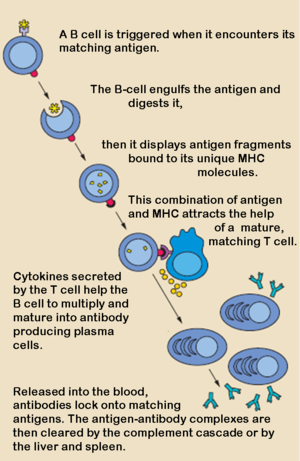B-lymphocyte

The action of B- and T-cells.
A B-lymphocyte is a type of lymphocyte (which, in turn is a type of white blood cell) that is the basis for the body's humoral immune system since it produces and secretes immunoglobulins (antibodies) in response to antigens. B-lymphocytes, also called B-cells, represent about 5–15% of the circulating lymphoid pool and are classically defined by the presence of endogenously produced immunoglobulins. Like all blood cells, B-lymphocytes develop in the bone marrow and then migrate to any of various parts of the body via the bloodstream.
When an antigen (a particular foreign protein, such as a substance on the surface of a bacterium) is encountered by the immune system, certain B-lymphocytes are stimulated to enlarge and undergo cell division, transforming into cells called plasma cells. The plasma cells secrete into the blood vast numbers of tailor-made immunoglobulins that attach to the antigen on the surface of the microorganism.
Disorders connected with B-cells
B-cell acute lymphocytic leukemia is a type of leukemia (blood cancer) in which too many B-cell lymphoblasts (immature white blood cells) are found in the blood and bone marrow. It is the most common type of acute lymphoblastic leukemia (ALL). Also called precursor B-lymphoblastic leukemia and B-cell acute lymphoblastic leukemia.
B-cell lymphoma is a type of cancer that forms in B cells. B-cell lymphomas usually occur in adults and may be either indolent (slow-growing) or aggressive (fast-growing). There are many different types of B-cell lymphomas, and prognosis and treatment depend on the type and stage of cancer.


